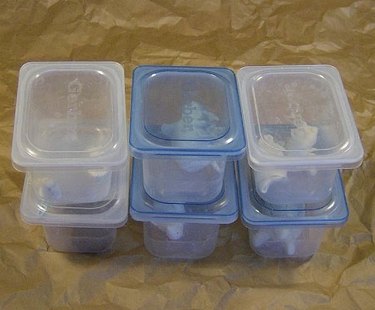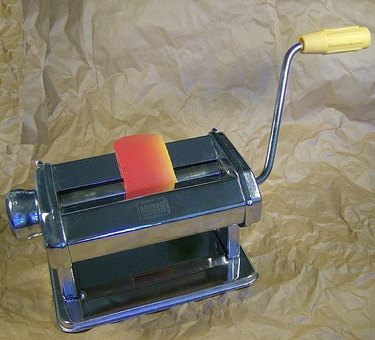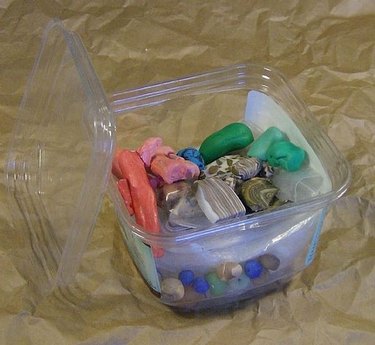Things You'll Need
Polymer clay
Containers
A cool place

Polymer clay will stay soft for a very long time under the right conditions. It doesn't dry out in the air, and if it does get dry, it can be softened using special products. I actually don't know if you can keep polymer clay forever (I haven't lived that long yet.) But I have some clay that is decades-old, and still good.
Step 1
Buying polymer clay:
Video of the Day
Press it with your fingernail, right through the plastic. If it cracks, or if the nail-print remains, it's too hard to work with, and it will probably be crumbly. If it bounces back, it's soft enough.
Buy dry clay at your own risk. Sometimes poly-clay may have been left sitting in a warm place (like a loading dock) and inadvertantly cooked. If clay has "cooked" at all, it's probably not good any more. (Exception: I have bought poly-clay at a deep discount, and sometimes it's perfectly good. It can be hard to tell through the plastic.)
Step 2

Keeping it soft:
Keep it in a cool, dry place. Cover it with plastic. Although poly-clay doesn't dry out the way real clay does, it does attract dust. Sandwich bags work fine. Even better, keep in the original package so you'll know the exact name of the color and have cooking instructions handy. (Different poly-clays cook at different times and temperatures.) Slip the packages into bead bags found at craft stores. Some kinds of plastic melt when they're in contact with polymer clay for any length of time. You can test this by leaving a wad on a sample of plastic.
I have only tried a few kinds of plastic. I can say this much: The original bag doesn't melt. Resealable bags (store brand) don't melt. Gl-d wrap doesn't melt. Plastic baby food jars (pictured) don't melt. Butter or "spread" tubs don't melt. Salsa cups (from Mexican food places) DO MELT!
Do not keep polymer clay in paper for any amount of time. The plasticizer will leach out into the paper and dry the poly-clay more quickly. Don't set clay on wood furniture, either, as it might soften the polish.
Step 3

Condition your clay before using it:
Wash your hands to remove oils and dust, and knead pieces of clay between your hands. As you roll it, the clay should become warm, soft and pliable. Some brands of clay are easier to condition than others. FIMO is the hardest, but it also makes a good, strong finished product. If you don't want to use your hands, you may buy a pasta maker. These are sold at craft stores from about $20.00 and up. (Be sure to bring a coupon!) Run the clay through the machine over and over again until it's soft and it doesn't crumble. (I prefer to use my hands. It's good exercise, and it's relaxing for me. A pasta maker might be a good investment, however, especially if you are working with large amounts of clay, if kneading clay is painful, or if you want to try some techniques that are best done with a pasta maker, such as blending colors.)
If you have kneaded the clay for more than a few minutes and it still crumbles, you may have dried-out clay.
Step 4
If your clay has dried, you have a few choices:
Return it to the store if it's new. Keep it to put inside larger pieces. Add softer clay or liquid clay softener. Add mineral oil. Clay softener is sticky, and too much will result in sticky, mushy clay, so add it drop by drop. You can mix in: Mix Quick, by FIMO (solid.) Sculpey Clay Softener (liquid.) TLS (Translucent Liquid Sculpey) works too. You can also mix in some Bake & Bend clay. Look for these in a craft store or online. Or just add some softer clay. Sculpey III is a good choice. If you can, choose a similar color. No matter what you do, I suggest starting with a small amount, until you feel comfortable with the ratio of dried clay to softener.
Step 5

Don't ever throw away scraps. Keep them to put inside bigger pieces. This will save you money, and keep the plastic out of landfills.
Tip
Wash your hands after handling polymer clay, and clean your tools with rubbing alcohol.
Warning
Polymer clay is "certified non-toxic," but this is controversial. I cook it in my home oven, but in a container that I do not cook in. You may prefer a toaster oven, and you may want to open a window. Keep poly-clay tools (rolling pin, pasta maker, knives, dishes,) separate from food tools. Use common safety-sense. Keep away from children, and wash your hands when finished working with it. (I let my grandchildren play with Play-Dough while I work.)
Video of the Day